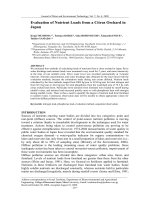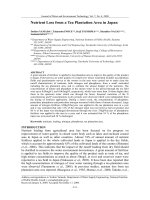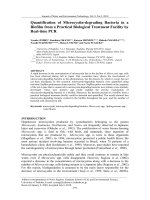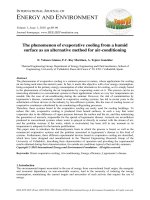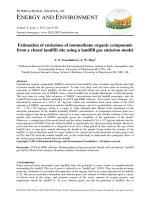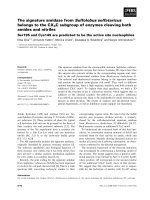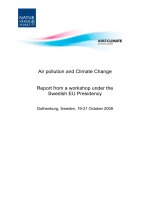From A Capital City to A World City Vision 2020, Multimedia Super Corridor and Kuala Lumpur
Bạn đang xem bản rút gọn của tài liệu. Xem và tải ngay bản đầy đủ của tài liệu tại đây (4.01 MB, 121 trang )
From a Capital City to a World City:
Vision 2020, Multimedia Super Corridor and Kuala Lumpur
A thesis presented to
the faculty of
the Center for International Studies of Ohio University
In partial fulfillment
of the requirements for the degree
Master of Arts
Jen Yih Yap
August 2004
This thesis entitled
From A Capital City to A World City:
Vision 2020, Multimedia Super Corridor and Kuala Lumpur
BY
JEN YIH YAP
has been approved for
the Program of Southeast Asian Studies
and the Center for International Studies by
__________________________________________________
Yeong-Hyun Kim
Assistant Professor of Geography
__________________________________________________
Josep Rota
Associate Provost, Center for International Studies
YAP, JEN YIH. M. A. August 2004. Southeast Asian Studies
From A Capital City to A World City: Vision 2020, Multimedia Super Corridor and
Kuala Lumpur (121pp.)
Advisor of Thesis: Yeong-Hyun Kim
In 1991, the former Prime Minister Tun Dr. Mahathir Mohamad introduced an initiative
called Vision 2020, designed to bring Malaysia to a developed country status, and this
initiative will eventually support Kuala Lumpur’s position to become a world city. This
thesis examines the recent urban restructuring of Kuala Lumpur in terms of the
Malaysian government’s current aspiration for world city status. Many capital cities in
the developing world have been undergoing various world city projects that aim at,
among other things, improving their international visibility, advancing urban
infrastructures and promoting economic competitiveness in a global world economy.
This thesis focuses on four large-scale constructions in the Multimedia Super Corridor,
namely, the Kuala Lumpur City Center, Kuala Lumpur International Airport, Putrajaya
and Cyberjaya. In addition, this thesis will provide a comparison of Kuala Lumpur’s
status in Southeast Asia.
Approved: ___________________________________________________
Yeong-Hyun Kim
Assistant Professor of Geography
Acknowledgements
I would like to express my deepest gratitude to my advisor, Dr. Yeong-Hyun Kim,
for her continued encouragement, patience and excellent guidance through the
completion of my thesis. I am also deeply indebted to my thesis committee, Dr. Kadir
Din and Dr. Christopher Boone, for their insightful advice and comments. I am grateful
that I received a travel grant from the Southeast Asian Program, which allowed me travel
to Kuala Lumpur, Malaysia and collect data for this thesis.
I also would like to thank all my friends in Ohio University for their informative
discussions and sharing of their knowledge. I thank Marianne and the tutors in the
Academic Advancement Center (especially Rachel and Micah) for proofreading
my thesis. I am also thankful to the Southeast Asian Collection, Ohio University library
for its resourceful academic collections on Malaysia.
I sincerely thank my parents, Yap Yew Tack and Law Seang Foong, my brother,
Kim Bee, and my sisters, Siew Pheng, Shiow Wen, and Siew Ruenn for their love and
support over all these years. Last but not least, I would like to thank my close friends,
Sean Hsieh, Yang Pei, and Vichea Tieng for their encouragement
5
Table of Contents
Page
Abstract 3
Acknowledgements 4
List of Tables 6
List of Figures 7
List of Abbreviations 9
Chapter 1
1.1 Introduction 10
1.2 Study Area 14
1.3 Research Methods 16
1.4 Literature Review 18
Chapter 2 – The Malaysia Economy and Vision 2020
2.1 The Growth of the Malaysian Economy 24
2.2 The Malaysian Government’s Economic Plans 33
2.3 Vision 2020 37
Chapter 3 – Kuala Lumpur as the Center of the Malaysian Economy
3.1 The Old Kuala Lumpur 41
3.2 The Modern Kuala Lumpur 45
3.3 Kuala Lumpur and Vision 2020 50
3.3.1 Regional Information and Communication Technology and
Multimedia hub 51
3.3.2 Regional Hub (Air Transportation Connections) 54
3.3.3 Regional Islamic Financial Center 56
3.3.4 Regional Education Center 59
3.4 Kuala Lumpur as a World Class City 60
Chapter 4 – Grounding Works for World City Status
4.1 The Kuala Lumpur City Center 62
4.2 Kuala Lumpur International Airport 68
4.3 Putrajaya 76
4.4 Cyberjaya 81
Chapter 5 – Kuala Lumpur as a Regional Center of Southeast Asia
5.1 Urban Restructuring in World Cities in Southeast Asia 93
5.2 Kuala Lumpur and Southeast Asian Cities 97
Chapter 6
6.1 Conclusions 111
References 114
6
List of Tables
Table Page
3.1 Malaysia Plans’ Budget Allocation for Kuala Lumpur 47
3.2 Kuala Lumpur as the Regional Center 51
3.3 Southeast Asian Stock Markets: Composite Index 57
4.1 Proportion of Land use in the Putrajaya 77
4.2 Number of Students Graduated from Multimedia University
at Cyberjaya, 1999-2003 86
4.3 Malaysian Companies in the Deloitte Tohmatsu Technology
Fast 500 in 2002 89
5.1 The Ranking of World’s Tallest Building and Planned Constructions of the
Next World Tallest Building 98
5.2 World Airport Ranking for the Number of Passengers in 2002 100
5.3 World Airport Ranking for the Total of Cargo in 2002 101
5.4 New Airport Projects in Asia Pacific 102
5.5 Top Five Digital Access Countries in the Developing Asia-Pacific 104
5.6 Asian Urban Hierarchy in Selected World Cities Studies 109
7
List of Figures
Figure Page
1.1 Vision 2020, Multimedia Super Corridor and Kuala Lumpur 13
1.2 Map of Malaysia 14
1.3 Kuala Lumpur Metropolitan Area and the Multimedia Super Corridor 15
2.1 Gross National Income (Atlas Method) of Malaysia, 1962-2002 25
2.2 Gross Domestic Product Per Capita of Malaysia, 1960-2002 26
2.3 Changes in the Economic Structure of Malaysia, 1960-2002 27
2.4 Malaysian Export and Import of Goods and Services, 1960-2002 28
2.5 Malaysian Foreign Direct Investment, 1974-2001 30
2.6 Gross Domestic Product Growth of Malaysia, 1961-2001 31
3.1 Urban Growth in the Klang Valley for Selected Years, 1990-2005 44
3.2 General View of Kuala Lumpur in the 1980s 45
3.3 Population of Kuala Lumpur 46
3.4 Distribution of Employment by Organizational Groups
in Five Major States, 1999 48
3.5 Functions of Kuala Lumpur Metropolitan Region 49
3.6 General View of Kuala Lumpur in the 1990s 50
3.7 The Developmental Phases of Multimedia Super Corridor 53
4.1 The Master Plan of Kuala Lumpur City Center 64
4.2 The Development Phases of Kuala Lumpur International Airport,
1998-2012 69
8
4.3 Total Passengers Handled by Kuala Lumpur International Airport
(1998 to 2002) 71
4.4 Total Domestic and International Passengers Handled by Kuala Lumpur
International Airport and All Other Airport in Malaysia, 2002 72
4.5 Total Cargo Handled by Kuala Lumpur International Airport,
and All Other Airports in Malaysia, 2002 73
4.6 Total Cargo Handled by Sultan Abdul Samad International Airport
(1992-2002), and Kuala Lumpur International Airport (1998-2002) 74
4.7 Total Commercial Aircraft Movement Handled by Kuala Lumpur
International Airport and All Other Airports in Malaysia, 2002 75
4.8 Map of Putrajaya 76
4.9 A Three-Year Physical Developmental Plan of Cyberjaya 82
4.10 MSC-status and Non MSC-status Companies in Cyberjaya 83
4.11 Employment in Multimedia Super Corridor, 1997-2003 (October) 87
4.12 Multimedia Super Corridor Companies by Sectors, 2003 88
5.1 A poster used for a joint tourism promotion for
Malaysia and Singapore 99
5.2 A book cover on urbanization in Southeast Asia 99
5.3 World Competitiveness of Infrastructure, 2002 105
5.4 Estimates and Rankings of e-Government Maturity by Country 106
5.5 Cities Bidding for the Summer Olympics, 2008 107
9
List of Abbreviations
AFTA ASEAN Free Trade Area
ASEAN Association of Southeast Asian Nations
CIC Capital Issues Committee
FIC Foreign Investment Committee
GDP Gross Domestic Product
GNI Gross National Income
IAP International Advisory Panel
IMF International Monetary Fund
KLCC Kuala Lumpur City Center
KLIA Kuala Lumpur International Airport
KLMR Kuala Lumpur Metropolitan Region
KLSE Kuala Lumpur Stock Exchange
MDC Multimedia Development Corporation
MSC Multimedia Super Corridor
MITI Ministry of International Trade and Development
WTO World Trade Organization
SARS Severe Acute Respiratory Syndrome
10
CHAPTER 1
1.1 Introduction
This thesis examines the Malaysian government’s efforts to promote its capital
city, Kuala Lumpur, as a world city. “World cities” are defined as primary centers of the
globalizing world economy (Short & Kim, 1999). According to this definition, New
York, London and Tokyo are three major world cities that have been recognized for their
disproportionate share of multinational corporation headquarters, stock markets,
international organizations, and global air networks. Thus, these cities are often called
first-tier world cities and global cities (Sassen, 1991).
After these three primary cities, however, there have been some disagreements on
what cities should be considered second-tier world cities. Friedmann (1995) argues for
Amsterdam, Frankfurt, Los Angeles, Miami and Singapore as regional centers following
the three major global centers in the hierarchy, while some argue that Paris and Chicago
should be included in the list of second-tier world cities (Beaverstock et al., 1999).
Understandably, more disagreements are observed further down in the global urban
hierarchy, since different indicators value different assets and characteristics that
individual cities have developed over the last decade.
There is a group of world cities commonly called “emerging world cities” (Lo &
Yeung, 1996), “wannabe cities” (Short & Kim, 1999) or gateway cities (Short et al.,
2000). These are large cities, mostly capital cities, in developing countries which have
served as connecting points between their respective countries and the wider world. A lot
11
of these cities’ world city status has been promoted by their national governments
through large-scale urban projects and/or international sports competitions (Olds, 1995).
Kuala Lumpur is such an example of an emerging world city. Indeed, many
capital cities in Southeast Asia have dreamed of attaining world city status, and, their
governments have undertaken various urban development projects in recent years. In
1991, Tun Dr. Mahathir Mohamad, former Prime Minister of Malaysia introduced a long-
term vision of the country, named “Vision 2020,” to achieve the goal of becoming a
developed economy by the year 2020. To become a developed country based on Vision
2020, Malaysia needs to prepare for a major shift from a manufacturing economy to a
knowledge-based economy. Much of the long-term national development plan is
concentrated on the restructuring of Kuala Lumpur, the country’s capital city. In an
effort to materialize the vision, the Malaysian government launched the Multimedia
Super Corridor (MSC) to promote its knowledge-based industries. The Multimedia
Super Corridor consists of four major large-scale projects, the Kuala Lumpur City Center,
the Cyberjaya, the Putrajaya and the Kuala Lumpur International Airport. Along with
these projects, the Kuala Lumpur government has also drafted the Kuala Lumpur Draft
Structural Plan 2020 in early 2003 to promote Kuala Lumpur for world-class status
(Figure 1.1).
The thesis pays particular attention to the Multimedia Super Corridor projects that
have significantly upgraded Kuala Lumpur’s infrastructure in the past decade, regardless
of the occurrence of the Asian financial crisis in 1997 to 1998. The construction of these
four large-scale projects continued despite the national economic growth plummeting to -
7%. The Malaysian government’s action to continue these constructions was strongly
12
criticized by some Malaysian societies. However, the voices of criticism on the
Malaysian government’s large-scale projects have becoming less as the national
economic growth has been recovering since 2001. Therefore, this thesis seeks to
examine the ways in which Kuala Lumpur has been restructured along with the Vision
2020 concept in pursuit of becoming a world city within the next 20 years.
13
Malaysia
V
ision 2020
Regional
Information
and Communication
Technology Hub
Regional Hub
Air
Transportation
Connections
Regional
Islamic
Financial
Center
Regional
Education
Center
C
y
ber
j
a
y
a
Putra
j
a
y
a
Kuala Lumpur City Center
Kuala Lumpur
International Airport
Kuala Lumpur as a World Class City
Kuala Lumpur
Government.
Kuala Lumpur
Structural Plan 2020
Multimedia Su
p
er Corridor
Kuala Lumpur
Government.
Kuala Lumpur
Structural Plan 2020
Kuala Lumpur Metropolitan Area
Figure 1.1: Vision 2020, Multimedia Super Corridor and Kuala Lumpur
14
1.2 Study Area
This thesis examines the recent urban restructuring of Kuala Lumpur, which has
been a capital city since 1896. Kuala Lumpur has been the primary center of Malaysia’s
economic growth in the past few decades, and it is again at the center of Malaysia’s goal
to become a developed country through the notion of Vision 2020.
The study focuses particularly on four large-scale construction projects of Kuala
Lumpur City Center, Cyberjaya, Putrajaya and Kuala Lumpur International Airport.
These four large-scale projects are all located in the Multimedia Super Corridor which is
in the Federal Territory of Kuala Lumpur including the urban area of Klang Valley and
part of the states of Negeri Sembilan and Selangor (Figure 1.2 and 1.3).
Figure 1.2: Map of Malaysia.
Source: Primedia Company.
15
Figure 1.3: Kuala Lumpur Metropolitan Area and the Multimedia Super Corridor.
Source: Kuala Lumpur Structural Plan 2005 with modification.
16
1.3 Research Methods
This thesis draws primarily on the information that I collected while conducting a
fieldwork in Kuala Lumpur in December 2003 and published statistical data on the
Malaysian economy, Kuala Lumpur and other Southeast Asian cities. The details of
Vision 2020 and the Multimedia Super Corridor were obtained from the Malaysian
government and Kuala Lumpur city government.
The economic statistical data are important to illustrate the economic
development of Kuala Lumpur and Malaysia beginning from Malaysia’s national
independence in 1957. It is also useful to compare Kuala Lumpur’s position with other
Southeast Asian cities in the regional urban hierarchy. I analyzed the content of Vision
2020 that is related to recent urban restructuring in Kuala Lumpur. Furthermore, a series
of unstructured interviews were conducted with some officials to ensure that some of the
information and data were accurate as well as to learn the officials’ views on Kuala
Lumpur becoming a world city.
I visited both the Malaysian-Industry Government Group for High Technology
(MIGHT) and the Ministry of Transportation, both of which are located in the Malaysian
government administration city of Putrajaya, part of the Multimedia Super Corridor
project. I collected statistical data on the economic and social development of Malaysia,
as well as statistics for air transportation. As for the information on Kuala Lumpur, I
visited the Kuala Lumpur city government to get a copy of Kuala Lumpur’s Structural
Plan and to gather information on Kuala Lumpur’s role and plan for the 21
st
century. I
17
also visited the economic department and tourism department of the Kuala Lumpur city
government.
In addition to collecting statistical data in Malaysia, I gathered statistical data
from several international organizations including the World Development Indicators
database of the World Bank and the ITU World Telecommunication Indicator database in
order to illustrate the economic development of Malaysia and to compare Kuala
Lumpur’s position in the Southeast Asian regional urban hierarchy.
While collecting the information and data, I also carried out unstructured
interviews with several officials associated with the four large-scale projects. I met with
the Principal Assistant Secretary of the Policy Unit (Corporate and International
Division) of the Ministry of Transportation, an executive in the corporate planning and
development of Kuala Lumpur city government, an officer in the Domestic and
International Affairs Department in the Kuala Lumpur city government, a Public
Relations manager of Kuala Lumpur City Center Bhd., a media relation executive of the
Multimedia Development Corporation, and an executive in the Corporate Services
Department of Bank Negara Malaysia (Central Bank of Malaysia). I also contacted a
senior manager from the research and planning department of Kuala Lumpur
International Airport and an officer from the Corporate Communications Division of
Putrajaya.
18
1.4 Literature Review
The notion of “world cities” emerged with the growth of an integrated and
dependent global economy. Generally speaking, world cities have a population of one
million or more. However, population and demographic aspects are not necessarily the
crucial element in the status of world cities (Yeung and Lo, 1998; Sassen, 1998). The
cities with high populations are rather known as the “mega-cities” (Beaverstock et al,
1999), and do not necessarily have as significant a role as world cities in the world’s
economic hierarchy. Therefore, the functions of the cities’ linkage with the global
economy, politics, and telecommunication networks (Smith and Feagin, 1987; Castells,
1989; Sassen, 1991; Friedmann, 1995; Yeung and Lo, 1998) are the key parameters to
acknowledge a city’s status as a world city.
The term “world cities” was first used by Patrick Geddes (1915) to describe the
place where world business was being carried out. Subsequently, Hall (1966) developed
the idea of world cities as “those in which quite a disproportionate part of the world
where most important business is conducted” (p.7). Although Hall did not provide any
explicit definition of world cities in his work, his general characteristics of world cities
have been echoed in much of his later world city research.
Friedmann’s work on “The World City Hypothesis” in 1986 was useful as a
framework for research on world cities (cited in Knox & Taylor, 1995, pp.317-331).
Friedmann revised the hypothesis a decade later but maintains the similar structure. He
defines world cities as “the centers for managing regional, national and international
global economic transactions; the centers used by global capital collection and capitalism
19
for production and markets; the urban areas of intense economy and social interaction;
the centers that can be ranked in hierarchically according to their economic power; and a
metropolitan area for the transnational capitalist social class” (Friedmann, 1995, p. 25-
26). According to these criteria, London, Paris, Rotterdam, Frankfurt, Zurich, New York,
Chicago, Los Angeles and Tokyo are the primary cities of the core countries’ category
(Friedmann, 1995) in his research.
Sassen (1991) ranks cities around the world according to the level of financial and
business services that individual cities provide. She also suggests that world
city
functions include highly concentrated command points in the organization of the global
economy, the main location for finance and for specialized service firms, sites of
production of innovations and as markets for the products and innovations produced. She
has identified New York, London and Tokyo as the three major “world cities” based on
the cities’ domination in financial and producer services in the world.
Beaverstock et al. (1999) conducts an extensive data collection project, named
Globalization and World Cities (GaWC), to rank cities around the world according to
their housing of major producer services firms in accountancy, advertising, financial
institutions and legal services. Through the study, Beaverstock et al. rank cities from the
top, medium, and lower level of world city status as “Alpha, Beta and Gamma” world
cities respectively. In their research, London, Paris, New York and Tokyo were the most
qualified top level, followed by Chicago, Frankfurt, Hong Kong, Los Angeles, Milan and
Singapore which were also included in the Alpha world cities (Beaverstock et al., 1999,
p. 456).
20
Other characteristics of world cities are explained in Pacione (2001). He
characterizes world cities according to their function as major centers for the public and
private business relations, political power and the major ports and airport hubs. Hall
(2001) also mentions that world cities can be distinguished by their concentration of
government and international agencies and headquarters, financial and commercial
services center (consultancy, accountancy, law firms, etc), urban tourism and cultural
entertainment centers (museums, performing arts, symphonies, etc). Furthermore, Short
& Kim (1999) describe world cities as control, command and management centers to
coordinate global manufacturing production, financial transactions, producer services and
telecommunication networks” (p. 54).
Despite all these efforts to identify world cities at the apex of global urban
hierarchy, exactly what constitutes a world city still remains vague. This remains so,
partly because the existing research has focused attention on the individual cities’
housing of major firms, banks and/ or stock markets. Also, cities’ international
connections are crucial to identify world cities in the era of globalization (Taylor, 1997;
Short et al., 2000). Beaverstock et al. (2002) identify the economic growth of world
cities as more related to the external relations than the internal assets that world cities
possessed with the case study of London, New York and Singapore.
Similarly, Short et al. (2000) identify those cities as “gateway cities,” which
widens the scope of identifying world cities. Their study of gateway cities has helped
identify the impact of globalization on cities that are below the top urban hierarchy of
world cities. Case studies on seven non-world cities including Barcelona, Beijing,
Havana, Prague, Seattle, Sioux Falls, and Sydney have shown the evidence of cities
21
connections with the wider world in different aspects. These cities have represented
themselves as “gateway cities” through their international competitiveness in
international events, their cultural uniqueness, global networks and economic growth.
Examples include Barcelona hosting the Olympics and World Cup Soccer, Prague
receiving the “European City of Culture” honor which has been used for tourism
publicity, global networks with Beijing’s urban area being opened to foreign investment,
and Seattle’s success economic growth with headquartering Starbucks and Amazon.
In efforts to rank cities according to certain indicators, many have looked also at
urban restructuring in world cities. Much attention has been paid to economic and spatial
changes in the so-called Third World cities (Smith, 1996; Armstrong and McGee, 1985),
emerging world cities (Lo and Yeung, 1996), world cities in poor countries (Gugler,
2004), or capital cities in developing countries such as Seoul (Kim, forthcoming),
Bangkok (Krongkaew, 1996; Kittiprapas, 2001; Jenks, 2003), Jakarta (Firman, 1998),
Singapore (Pow, 2002) and Kuala Lumpur (Bunnell, 1999; Bunnell et al., 2002).
Kim (forthcoming) explains that Seoul gained international visibility through
hosting the Olympic Games in 1988 and co-hosting FIFA World Cup Korea/Japan in
2002. The preparation of both games also upgraded the construction infrastructure of the
city. The construction of the waterfront, the freeway, the Olympic park, and the business
and financial districts have upgraded Seoul’s image of becoming a second-tier world city.
The Extended Bangkok Region has been attracting large amount of international
investment in the heavy industries in this extended region (Kittiprapas, 2001). Laem
Chabang Port, Bangkok International Airport and the transportation system in Bangkok
22
have been upgraded to assist the economic growth of the city (Kittiprapas, 2001; Jenks,
2003).
The development of Hanoi began with the introduction of Doi Moi policy, which
is an open-door policy to promote economic growth in Vietnam. This policy has
encouraged the development of commercial and retail centers in Hanoi (Quang &
Kammeier, 2002). Firman (1998) indicates that Jakarta has been playing a major role as
the mediator for foreign investment in the industrial area of Jakarta Metropolitan Area,
which consists of the three large cities of Jakarta, Bogor and Tangerang (Jabotabek). To
accommodate the growth of the services sector in Jakarta, the local government has
converted slum areas into office spaces and integrated and multiuse complexes.
According to Pow (2002), the city-state development of Singapore is supported by
the Urban Redevelopment Authority. The authority implemented a “pro-business”
strategy to boost the city-state to become a “international business hub.” Suntec city is an
example of the private and world class commercial development of real estate by Hong
Kong’s investors (Pow, 2002). In the case of Kuala Lumpur, Bunnel (1999) and Bunnell
et al. (2002) have described that both the Malaysian federal government and Kuala
Lumpur city government have also been upgrading the Kuala Lumpur Metropolitan area
with the large-scale construction of Kuala Lumpur City Center, Cyberjaya and Putrajaya
to be competitive in the globalizing economy.
Gugler (2004) examines major cities in developing countries which have recently
experienced significant makeovers, while their national governments have promoted
them to play major regional and global roles. Thus, the specific definition of world cities
23
is difficult because of the diversified characteristics of each city, but they are all at the
point of integration with globalization (Gugler, 2004).
Similar to other emerging world cities such as Bangkok (Krongkaew, 1996),
Jakarta (Firman, 1998), and Manila (Solon, 1996), Kuala Lumpur has been upgraded with
large-scale infrastructure, including advanced information and communication
technology facilities to integrate with the global networks, especially with cities in
developed nations. The “Information Age Project” in Malaysia started with the
introduction of the Multimedia Super Corridor, which will be the engine of economic
growth in Malaysia. Therefore, this thesis seeks to look at recent changes in Kuala
Lumpur which have been supported by the Vision 2020 concept in pursuit of world city
status.
24
CHAPTER 2
The Malaysian Economy and Vision 2020
2.1 The Growth of the Malaysian Economy
Peninsular Malaysia was known as the Federation of Malaya when it gained
independence in August 31, 1957. The Federation of Malaya was then replaced with
“Malaysia” when Sabah, Sarawak, and Singapore joined the federation in 1963.
However, Singapore was expulsed from the federation in 1965 for political reasons.
Malaysia covers an area of 128,606 sq mile (329,758 sq. km.), and is comprised of
fourteen states and two federal territories with a population of 24 million people. Its
national independence marked the starting point of the country as endeavor to build its
own future.
Malaysia has had stable economic growth since its independence in 1957. The
annual Gross National Income (GNI) growth rate average was 6% in the 1960s and
increased to an average of about 8% in the 1970s and 1980s (Figure 2.1) (World Bank,
2004). It continued to grow rapidly on an average of about 12% in the 1990s prior to the
Asian financial crisis. The Gross Domestic Product (GDP) per capita was less than
US$1,000 following the national independence. After 45 years of national independence,
the present (2003) GDP per capita has increased almost five-fold, to US$4,811 (World
Bank, 2004). This GDP growth has been enabled by export-oriented industrialization in
the 1980s, which had an average of 5% annual GDP growth, and the high-technology
manufacturing industry in the 1990s, which had an average of 7% annual GDP growth.
25
However, the GDP growth was not sustained during the Asian financial crisis that started
in mid-1997 and lasted through 1998. The financial crisis pulled the Malaysia’s GDP
growth to -10% in 1998 (Figure 2.2).
0
20
40
60
80
100
120
196
2
19
6
4
196
6
19
6
8
197
0
1972
1
97
4
1976
1
97
8
198
0
1
98
2
198
4
19
8
6
198
8
1990
1
99
2
1994
1
99
6
199
8
2
00
0
200
2
Billions
US Dollar (Current 1995
)
Figure 2.1: Gross National Income (Atlas Method) of Malaysia, 1962-2002.
Source: World Development Indicators Database by World Bank. (2004).
